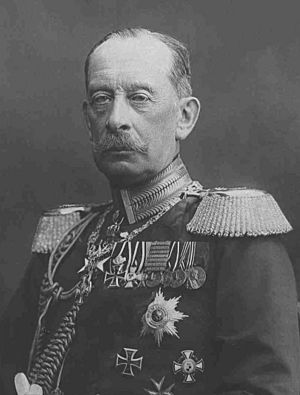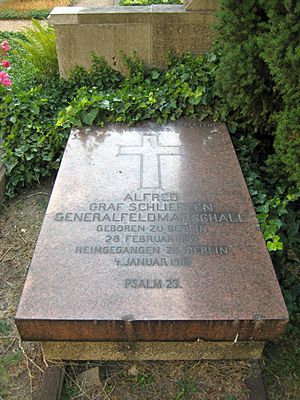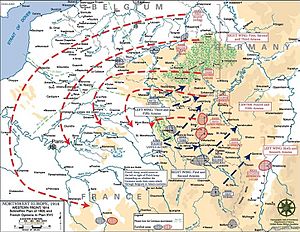Alfred von Schlieffen facts for kids
Quick facts for kids
Generalfeldmarschall Graf
Alfred von Schlieffen
|
|
|---|---|

Alfred von Schlieffen in 1906
|
|
| Chief of the German Great General Staff | |
| In office 7 February 1891 – 1 January 1906 |
|
| Monarch | Wilhelm II |
| Chancellor | |
| Preceded by | Alfred von Waldersee |
| Succeeded by | Helmuth von Moltke the Younger |
| Personal details | |
| Born | 28 February 1833 Berlin, Province of Brandenburg, Kingdom of Prussia, German Confederation |
| Died | 4 January 1913 (aged 79) Berlin, German Empire |
| Resting place | Invalidenfriedhof, Berlin |
| Spouse |
Anna Gräfin von Schlieffen
(m. 1868; died 1872) |
| Children | 2 |
| Known for | the Schlieffen Plan |
| Military service | |
| Allegiance |
|
| Branch/service | |
| Years of service | 1853–1906 |
| Rank | |
| Commands | 1st Guards Uhlans |
| Battles/wars | |
| Awards | Order of the Black Eagle |
Alfred von Schlieffen (born February 28, 1833 – died January 4, 1913) was a very important German field marshal and military thinker. He was the chief of the German General Staff from 1891 to 1906. He is best known for the "Schlieffen Plan", a military strategy he developed in 1905–06. This plan was designed to help Germany win a war if it had to fight on two fronts at the same time, especially against France and Russia.
Contents
Biography of Alfred von Schlieffen
Alfred von Schlieffen was born in Prussia, Germany, on February 28, 1833. His father was an officer in the Prussian Army. Alfred came from an old noble family. He lived with his father on their family estate in Silesia until he went to school in 1842.
When he was young, Schlieffen wasn't very interested in joining the military. So, he didn't go to the special military schools. Instead, he studied law at the University of Berlin. But in 1853, he joined the army for his one year of required military service. After that, he decided to stay in the army and became an officer candidate. He had a long military career, serving for 53 years.
In 1868, Schlieffen married his cousin, Anna Schlieffen. They had two daughters. Sadly, his wife died after their second child was born. After her death, Schlieffen focused all his energy on his military work.
Schlieffen's Military Career
Because his commanders recommended him, Schlieffen was accepted into the General War School in 1858. He was only 25, which was much younger than most students. He graduated in 1861 with high honors. This meant he was guaranteed a job as a General Staff officer.
In 1862, he worked in the Topographic Bureau of the General Staff. This job taught him a lot about geography. He learned how important the land and weather were for military plans. This knowledge helped him throughout his career, especially when he created war plans like the famous Schlieffen Plan.
Schlieffen first experienced war as a staff officer in 1866 during the Austro-Prussian War. He was part of the Battle of Königgrätz. This battle involved surrounding the enemy, and this idea became a key part of his military thinking.
During the Franco-Prussian War, he led a small group in the Loire Valley. This was a very tough campaign for the Prussian Army. After the war, he was promoted to Major. He then worked closely with other important military leaders like Helmuth von Moltke the Elder.
Schlieffen continued to rise through the ranks. In 1886, he became a Major General. He later became Deputy Chief of Staff and then Lieutenant General. By 1893, he was a General of the Cavalry.
In 1904, during a conflict in German South West Africa (now Namibia), Schlieffen supported strong actions against local groups. He believed that once a conflict started, it could only end with one side completely winning or losing. He agreed with orders that were very harsh, even for women involved in the fighting. However, after the German Chancellor Bernhard von Bülow worried about Germany's image around the world, Schlieffen agreed to change these harsh orders in December 1904.
In August 1905, Schlieffen was injured by a horse. At 72 years old, he decided to retire. He left the army on New Year's Day, 1906. He passed away on January 4, 1913, just 19 months before World War I began.
The German Army and Schlieffen's Ideas
Schlieffen worried that the German army was smaller than France's army. This was made worse by the alliance between France and Russia. He believed that Germany's military skills couldn't make up for having fewer soldiers.
Schlieffen wanted Germany to have universal conscription, meaning everyone would serve in the army. He also wanted to create many new units from trained reserve soldiers when war broke out. However, the War Ministry didn't agree with his ideas at first.
He continued to believe that using large numbers of reserve battalions was very important. This idea was central to his famous "Schlieffen Plan" memorandum in 1906. This document wasn't a final war plan. Instead, it showed what Germany could achieve if it used universal conscription and had a much larger army. The huge number of divisions needed for this plan didn't exist in 1906 or even in 1914.
Schlieffen's War Planning
A key part of Schlieffen's war planning was the idea of a "strategic counter-offensive." This means letting the enemy attack first, then hitting them back very hard. Schlieffen believed Germany could use its railways to quickly move troops. They could defeat one enemy, then quickly move their soldiers to fight the other enemy.
He also understood that sometimes an army needs to attack first. In 1897, he developed a plan to get past France's strong defenses on their shared border. He thought it was important to go around the French forts to the north and attack them from north to south, starting near Verdun.
In 1905, Schlieffen created his first real plan for a big attack. This was the famous Schlieffen Plan memorandum. This plan was based on the idea of a war only between France and Germany, without Russia involved. It suggested that Germany should attack France.
The plan suggested that Germany would need more soldiers. It also said that German forces would move through the Netherlands and northern Belgium. They would protect southern Belgium and Luxembourg to keep Germany safe from a French attack during this move.
Schlieffen's genius showed in the second part of his plan. He saw how strong France's second line of defense was, especially around Verdun, Paris, and the Marne River. He knew that to win, German forces would need to cross the Seine River to the west of Paris. If they could do this with enough strength, they might be able to push the French back from the Marne and even surround Paris.
However, most of Schlieffen's plans still favored a counter-offensive. He believed that Germany's best chance for survival in a war against both France and Russia was to defend first.
In 1905, after his injury, Schlieffen began planning his retirement. Helmuth von Moltke the Younger became the new Chief of Staff after Schlieffen retired.
Moltke tried to use Schlieffen's offensive plan against France in 1914, even though Germany was fighting on two fronts (against France and Russia). Schlieffen had warned that this offensive plan would only work if Germany was fighting France alone. Because Moltke had too few troops to carry out the plan as Schlieffen intended, the German attack failed at the Battle of the Marne.
Schlieffen's Influence

Schlieffen was one of the most famous military thinkers of his time. He wrote an important book called Cannae. This book was about an ancient battle in 216 BCE where Hannibal defeated the Romans by surrounding them. Schlieffen used this battle to explain his ideas about how to surround an enemy.
His ideas were studied a lot in military academies, especially after World War I. American military leaders thought his work was so important that they translated Cannae for their army.
Schlieffen was known for being a great strategist. Unlike some other military leaders, he stayed away from politics. He focused on preparing war plans and making sure the German Army was ready for battle. He spent a lot of time on training, military education, and using new technology for military purposes.
He believed it was important to teach young officers to take responsibility for planning and directing military movements. General Walter Bedell Smith, a chief of staff during World War II, said that many American officers were inspired by Schlieffen's ideas of bold movements to achieve decisive results.
General Erich Ludendorff, another important German military leader, called Schlieffen "one of the greatest soldiers ever." Schlieffen's ideas about surrounding the enemy were used by Ludendorff in the Battle of Tannenberg.
Long after his death, German military officers in the years between the World Wars and during World War II used Schlieffen's theories to develop the Blitzkrieg (lightning war) strategy.
Quotations
- "A man is born, and not made, a strategist."
- "To win, we must endeavour to be the stronger of the two at the point of impact. Our only hope of this lies in making our own choice of operations, not in waiting passively for whatever the enemy chooses for us."
Honours and awards
- German decorations
 Prussia:
Prussia:
- Iron Cross (1870), 1st and 2nd Classes
- Grand Cross of the Red Eagle, with Oak Leaves, Swords on Ring and Crown
- Knight of the Prussian Crown, 1st Class
- Grand Commander's Cross of the Royal House Order of Hohenzollern
- Knight of the Black Eagle, with Collar and Diamonds
- War Commemorative Medal of 1870/71
- Kaiser Wilhelm I Centenary Medal
 Hohenzollern: Cross of Honour of the Princely House Order of Hohenzollern, 1st Class
Hohenzollern: Cross of Honour of the Princely House Order of Hohenzollern, 1st Class Baden:
Baden:
- Grand Cross of the Zähringer Lion, with Oak Leaves, 1893
- Knight of the House Order of Fidelity, 1899
 Bavaria:
Bavaria:
- Grand Cross of Merit of the Bavarian Crown, 1897
- Knight of St. Hubert, 1903
- Grand Cross of the Military Merit Order
 Hesse and by Rhine: Grand Cross of the Ludwig Order, 9 April 1903
Hesse and by Rhine: Grand Cross of the Ludwig Order, 9 April 1903
 Lippe: Cross of Honour of the House Order of Lippe, 1st Class
Lippe: Cross of Honour of the House Order of Lippe, 1st Class Mecklenburg:
Mecklenburg:
- Grand Cross of the Wendish Crown, with Golden Crown
- Military Merit Cross, 1st Class (Schwerin)
 Oldenburg: Grand Commander of Honour of the Order of Duke Peter Friedrich Ludwig
Oldenburg: Grand Commander of Honour of the Order of Duke Peter Friedrich Ludwig Saxony:
Saxony:
- Grand Cross of the Albert Order, with Golden Star, 1891
- Knight of the Rue Crown
 Württemberg:
Württemberg:
- Grand Cross of the Württemberg Crown, 1893
- Grand Cross of the Friedrich Order, 1893
- Grand Cross of the Military Merit Order, 28 March 1903
- Foreign decorations
 Austria-Hungary:
Austria-Hungary:
- Knight of the Iron Crown, 1st Class, 1890
- Grand Cross of the Imperial Order of Leopold, 1891; in Diamonds, 1895
- Grand Cross of St. Stephen, 1897
 French Empire: Officer of the Legion of Honour
French Empire: Officer of the Legion of Honour Kingdom of Italy:
Kingdom of Italy:
- Grand Cross of Saints Maurice and Lazarus
- Grand Cross of the Crown of Italy
 Netherlands: Grand Cross of the Netherlands Lion
Netherlands: Grand Cross of the Netherlands Lion Ottoman Empire: Order of Osmanieh, 1st Class in Diamonds
Ottoman Empire: Order of Osmanieh, 1st Class in Diamonds Persian Empire:
Persian Empire:
- Order of the August Portrait
- Order of the Lion and the Sun, 3rd Class
 Russian Empire: Knight of St. Alexander Nevsky, 1897
Russian Empire: Knight of St. Alexander Nevsky, 1897 Siam: Grand Cross of the White Elephant
Siam: Grand Cross of the White Elephant
See also
 In Spanish: Alfred von Schlieffen para niños
In Spanish: Alfred von Schlieffen para niños


